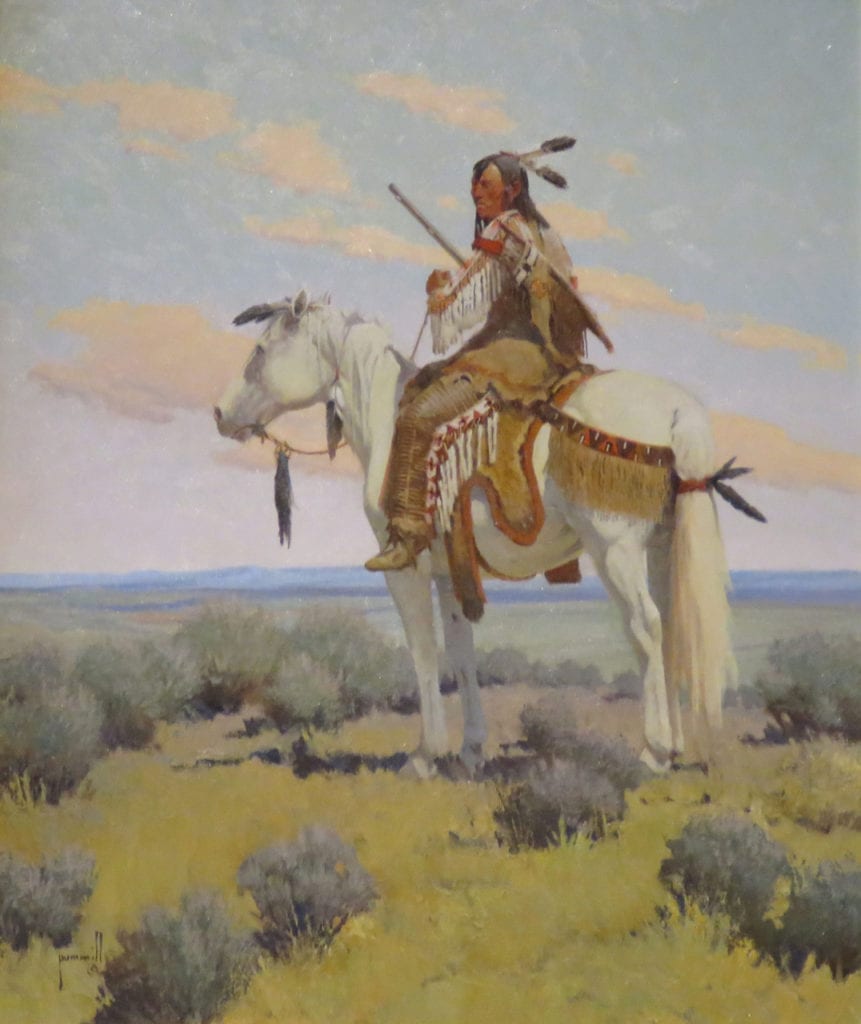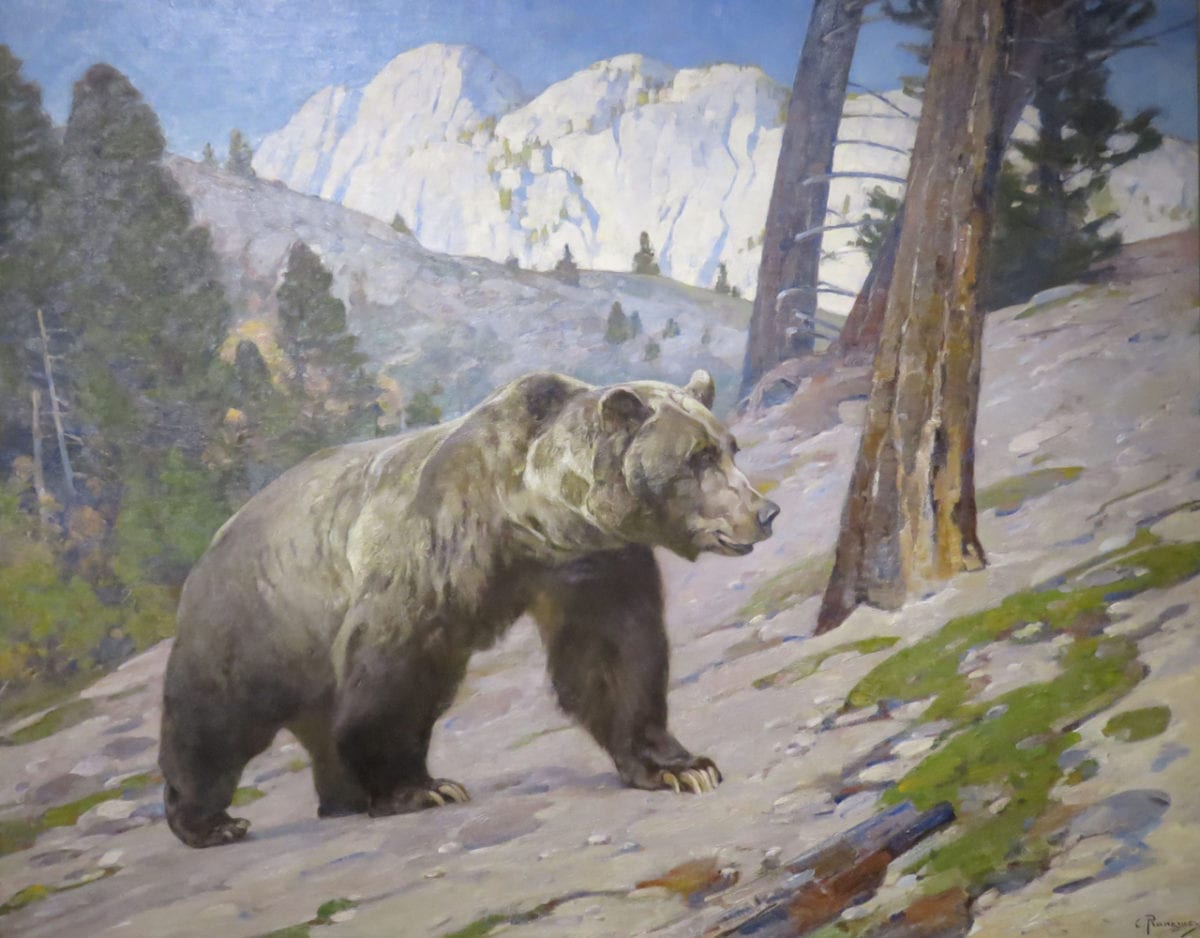
A statue of Buffalo Bill Cody by the Center of the West Museum in Cody, Wyoming: Glynn Wilson [More photos below: click on the image to see a larger view]
Watch the video –
By Glynn Wilson –
“Buffalo Bill” Cody is a name that conjures up romantic images of the American “Wild West” in the 19th century.
It’s almost unfortunate in the 21st century when there is a renewed interest in justice for Native Americans that the name of William Frederick “Buffalo Bill” Cody is still attached to one of the best museums in the United States associated with the The Smithsonian Institution in Washington, D.C.
Unfortunate, maybe, but inevitable, since the most famous cowboy of all time founded the town of Cody Wyoming in 1895 at the eastern entrance to Yellowstone National Park. It had been set aside as the first national park in the country and the world by President Ulysses S. Grant on March 1, 1872.
More than 200,000 tourists a year from all over the country and the world still flock to Cody to gawk at the legend of Buffalo Bill, and to see the largest collection of guns in the country at the Cody Firearms Museum. It’s even bigger than the collection of the National Rifle Association (NRA) in its National Firearms Museum in Fairfax, Virginia.
But that’s not why I highly recommend a trip to Cody on the way into Yellowstone to visit the Buffalo Bill Center of the West museums. It’s really five museums in one. If you have limited time to visit, skip the Buffalo Bill exhibit and the firearms exhibit. But don’t miss the Whitney Western Art Museum.
One reviewer from the New York Times called the collection “uninspiring,” but what the heck do they know? I guess if you grow up in Manhattan down the street from the Metropolitan Museum of Art, a.k.a. The Met, it might not seem so impressive. But for a poor kid from Alabama — or anywhere else — with a childhood fascination with cowboys and indians, it is something to see, for sure. (Yes, Virginia, I’ve been to The Met in New York and seen the Picasso exhibit).
If you do get a chance to pass through Cody on your way to Yellowstone, one of the grand wonders of the world, don’t miss the Draper Natural History Museum, which will show you the Greater Yellowstone Ecosystem and connect you with the nature there. You will know more about what you’re looking at once inside the park (see video above). The Draper has garnered international acclaim for its innovative, informative and inspiring exhibit experiences. It’s a premier scientific resource for the wildlife and ecology of Yellowstone.
You don’t want to miss the Plains Indian Museum, especially if you’ve been following the struggles of the Standing Rock Sioux Tribe in North Dakota to fight the Dakota Access Pipeline. This museum tells the significant story of the lives of Plains Indian peoples, which includes the Lakota Sioux, their cultures, traditions, values and histories, as well as the contexts of their lives even in modern times (see video).
Massacre at Wounded Knee
One of the stories fleshed out there involves the infamous date of December 29, 1890, 14 days after Sioux Chief Sitting Bull’s death. The Cavalry surrounded a group of Sioux participating in the Ghost Dance Ceremony when an altercation broke out between a U.S. soldier and a member of the Sioux tribe when he refused to give up his firearm. The battle resulted in the deaths of more than 150 Native American men, women and children, and at least 20 U.S. Cavalry soldiers. The event came to be known as “The massacre at Wounded Knee Creek.”
Hopefully the Standing Rock Sioux can avoid a repeat of that massacre in the water protectors’ protest to stop the “black snake” oil pipeline from crossing and polluting the Missouri River on the reservation border.
We highly recommend a visit to the museum, but perhaps keep in mind an academic reason why celebrating so-called great men like Buffalo Bill might not be such a great way to understand history. It was Charles Darwin’s so-called “Bull Dog,” one of the fathers of evolution and sociology, Herbert Spencer, who first attacked the Great Man Theory of history.
No doubt the average tourist and Trump voter would come to Cody to see the famous cowboy who allegedly rode for the Pony Express, scouted for the Union Army, hunted bison and put on a traveling show in the waning days of the wild west. But for the more sophisticated traveler, skip the Buffalo Bill and gun exhibits and learn about the Plains Indians, the natural history of Yellowstone and check out an impressive collection of western art. Not only does it contain original paintings from Thomas Moran and Albert Bierstadt, which the Times barely mentions in passing. They both helped pave the way turning public opinion in favor of establishing Yellowstone.
Not mentioned at all by the Times, the museum as redesigned in 2012 shows off an entire exhibit on Frederic Remington, an American painter, illustrator, sculptor, and writer who specialized in depictions of the Old American West. He concentrated specifically on the last quarter of the 19th-century and images of cowboys, American Indians and the U. S. Cavalry. You can hear the recorded voice of his daughter talking about the man and his art while you look at his paintings displayed in a re-creation of his camp where he worked and created art in the 19th century (see video).
All five museum exhibits are connected with a coffee shop in the middle in the shape of spokes on a wheel, and the effect is something approaching extraordinary. Incorporating the evolution of American guns with the European settlers confrontations with the Plains Indians might make for stories in themselves, as does the story of Buffalo Bill. Add in the natural history of the place and its awe inspiring beauty, along with attempting to show and explain the culture of the original inhabitants, and what you have is something more ambitious than a simple circus or a show. The aim is a more universal understanding of something larger even than a John Ford film set in this landscape. Of course you have to spend the time to take it all in and grasp the larger meaning.
Cody Wyoming
There are other sites to see in Cody. If you want to feel a little bit like a cowboy while you’re in town, get yourself a cowboy hat and pony up to the cherrywood bar, a gift from Queen Victoria to Buffalo Bill, at the Irma Hotel for a shot or two of Wyoming whiskey and a locally brewed IPA. It is listed on the National Register of Historic Places and was built for and named after Cody’s daughter. It’s a great place for a Facebook selfie.
More Photos

A painting of Plains Indians in a hand-crafted canoe possibly on the Missouri River. “Radisson and Groseilliers,” Frederic Remington, 1905: Glynn Wilson

























great information…awesome photos….
Thanks to the staff of the Buffalo Bill Center of the West for providing detailed information on the name of some of the paintings, the date and the painter credit after this story was shared on Facebook.
The staff wanted to say that William F. “Buffalo Bill” Cody’s Wild West (not “circus”) traveled for 30 years. Moving the equipment, animals, and people (400-800 depending on the season), was a logistical feat that military classes often study. Buffalo Bill was the original “equal opportunity employer,” paying all the personnel equal pay for equal work, regardless of whether they were cowboys, Indians, women, gauchos, Arabs, etc. He loved kids, and often gave all a town’s children free admission. We here in Cody are thankful for his founding of the town, and jumpstarting a project to bring irrigation water downstream, an effort that led to the building of the Buffalo Bill Dam. He built the Irma Hotel in downtown Cody, naming it for his daughter Irma. He boosted tourism in the area by bringing folks to Yellowstone, a place he loved. He was definitely a showman, bigger than life, and a frontiersman who regretted his participation in the Indian Wars. He and Sitting Bull became friends as well as Chief Iron Tail. The “town builder” section of the Buffalo Bill Museum is really interesting, looking at the man, rather than the showman.
“We loved this remark: ‘the aim is a more universal understanding of something larger even than a John Ford film set in this landscape.’ Gotta love John Ford!”